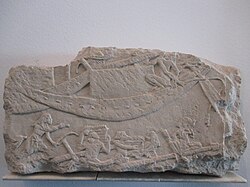Relief fragment with a harbor scene
| Relief fragment with a harbor scene | |
|---|---|

|
|
| material | limestone |
| Dimensions | H. 27.5 cm; W. 54.7 cm; T. 8.5 cm; |
| origin | unknown |
| time | New Kingdom , 18th Dynasty , |
| place | Hildesheim , Roemer and Pelizaeus Museum , PM 2370 |
The relief fragment with a harbor scene is in the Egyptian collection of the Roemer and Pelizaeus Museum in Hildesheim . This fragment originally belonged to a larger harbor scene. Parts of four barges and members of the ship's crew at work can be seen in varying degrees of preservation. The limestone object in raised relief dates to the New Kingdom , late 18th Dynasty, approx. 1300 BC. Chr.
Site and state of preservation
The location of the relief fragment is unknown. It was bought by Wilhelm Pelizaeus in 1914 and given to his hometown Hildesheim. The block is bumped on all corners and edges, larger flaws can be found on the right edge and the lower left corner, minor damage affects the face of the crouching man next to the rudder in the lower right ship and the legs of the standing man.
description
The relief fragment shows two barges in the upper section, the right one is almost completely preserved and the front part of the left one. Below that are parts of two other cargo ships that are being unloaded, with their masts and yards folded down . In the upper area, the rectangular ends of the ceiling joists are indicated at regular intervals on the ship's hulls. The cabin superstructure and the lower mast sections are particularly well preserved. The stern and hull appear equally long, which is typical for river boats. The actions of the workers are shown very vividly, with clear differences in expression and movements. In the top right boat, a man crouches next to the rudder, his torso turned back for fishing. He looks down at the end of the line from which a fish is hanging. From the ship behind to the left, the right end of the cabin and the remains of the rudder and one of the crew members are visible. The hull of this ship continues in a connection block that is now in the Brooklyn Museum in New York (inventory number 48.112). This also shows the remains of a third ship in the top row. Five people are depicted on the ships in the lower row of the Hildesheim block. The person standing on the left holds a whip or whip in his left hand and wears a soldier's apron. The man appears to be an overseer or driver who stands on the cabin roof of one of the ships. This scene also continues on the subsequent Brooklyn fragment. Four other people crouch in front of the guard, possibly prisoners. Directly in front of him, a man is holding a basket or a box on his shoulders. In the middle, a beardless man and a woman with long hair carry such an object together. The man sitting next to it on the right crouches seemingly indifferent on a folded mast of the second ship. His hair is half length. This scene shows the loading and unloading of a ship.
The relief fragment comes from a Memphite grave of the Post-Marna era , because at that time high dignitaries such as Haremhab had prisoners' performances in their graves. The scenes take place in an inland port, probably in Memphis , where goods, but also booty and prisoners from all over the world have been delivered.
literature
- Günther Roeder , Albert Ippel : The monuments of the Pelizaeus Museum in Hildesheim. Curtius, Berlin 1921, pp. 88-89.
- Hans Kayser : The Egyptian antiquities in the Roemer-Pelizaeus-Museum in Hildesheim. Gerstenberg, Hildesheim 1973, ISBN 3-8067-8002-1 , p. 69 (fragment of a limestone relief depicting cargo ships) and Fig. 50 (ships in port).
- Martin von Falck: relief fragment with a harbor scene . In: Katja Lembke (ed.): Life on the Nile and everyday life in ancient Egypt (= The ancient Egypt in Hildesheim ). tape 2 . von Zabern, Darmstadt / Mainz 2011, ISBN 978-3-8053-4285-8 , p. 92–93 (catalog for the permanent exhibition).
Web links
- Entry as well as pictures and description at The Global Egyptian Museum
- Brooklyn Museum: Harbor Scene